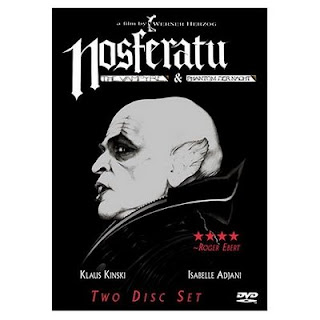
Werner Herzog is a filmmaker I need to follow more than I do. I saw some clips of his work in a film and television class in high school, and was struck by how intense it was, but- I honestly have no excuse for not having seen anything of his in full until recently. AGUIRRE is in the queue, honest. In the meantime, I’m going to continue the Club’s informal Halloween celebrations with Herzog’s remake of NOSFERATU, the samizdat Dracula classic of silent cinema. I’ve seen Murnau’s original, and this is an interesting companion piece, very similar to it in some ways yet very different in others. It’s also a really moody and impressive horror story in itself, and gives Herzog many opportunities to show his unique talents.
The story is roughly similar to DRACULA, except that the action has been relocated from London to Wismar, Germany (and a few decades earlier). Johnathan Harker (Bruno Ganz), who works as a real estate agent, is sent to Transylvania to close a deal with Count Dracula (Klaus Kinski), a pale and disfigured creature whom the locals seem to fear with good reason. Sure enough, Dracula is a vampire, and Johnathan barely escapes with his life, only to find that the Count has moved to Wismar already, bringing with him a horde of rats and a rash of mysterious deaths that are attributed to the return of the plague. In a change from Bram Stoker’s story, Johnathan is bordering on undead himself and Dr. Van Helsing (Walter Ladengast) is a skeptic, so it’s up to Johnathan’s wife Lucy (Isabelle Adjani) to put an end to the Count’s predations.
(People who have read DRACULA (or seen the Universal movie, or the Coppola version, or most roadshow productions, etc.) will recall that Johnathan was actually in love with Mina in the original story, and Lucy was another woman killed by the Count to demonstrate to the reader what he was capable of. This wouldn’t be worth more than a footnote if not for the fact that the same year, 1979, also saw the release of another film version of DRACULA starring Frank Langella, in which Lucy and Mina also switch places for no reason. The coincidence is enough to merit a parenthetical. End of digression.)
The first thing that struck me about Herzog’s NOSFERATU was its realism. Much of this was shot on location in Central Europe, not quite Transylvania proper but very close. Most film versions of the Count’s environs have been very bleak and stylized, following on from the Tod Browning film, but this film’s Transylvania is lush and alive and fairly authentic, but never lacking a sense of something horrible lurking in the clouds above. There is a magical quality to the scenes of Harker trekking towards Castle Dracula, walking alone because nobody will drive him by carriage or even sell a horse. Herzog enjoys lingering on landscapes, and when they’re this amazing I can’t blame him; that this is the kind of place where the vampire legends first spread lends the story an eerie reality.
Some of the intensity is lost when we move back to Wismar, but as in the original, the use of plague imagery and the association of the Count with the disease bearing rats (to be fair, this time they seem just to be patsies so Dracula can kill loads of people without anyone getting suspicious) is creepy and effective. Klaus Kinski’s Dracula, his appearance based on Max Shreck’s Count Orlock in the original, is a cold and inhuman figure, seemingly lacking in romantic qualities; he kills to feed and doesn’t seem to enjoy that either, expressing a dulled resentment of his own immortality. But Lucy is very appealing, and possesses a passion he has long since lost. There’s little that’s romantic about this, but it’s played very well.
This is not a fast-moving picture, though at 107 minutes it doesn’t outstay its welcome. Herzog relies a lot on building mood through static shots and the use of highly atmospheric music; the soundtrack contains some original work by Popol Vuh along with quotes from Wagner and Charles Gounod, and most notably the piece “Brothers of Darkness, Sons of Light” performed by Vuh and written by Florian Fricke. That piece in particular, an amelodic choral hum, is used as the main theme and establishes just the right sense of unease.
I find that this year I’m interested in horror films that create a sense of another world. With so much going on in the here and now, the idea that there’s more, that there are parts of the universe beyond natural comprehension, is almost comforting even when their inhabitants are threatening to kill us. NOSFERATU, like most great vampire stories, isn’t just about someone sucking blood- it’s about a netherworld of magic and danger that lurks out of our view, with Dracula as its emissary. Before I go overboard and start writing Goth poetry, though, I’ll conclude by saying this is a uniquely unnerving experience. I’d recommend seeing Murnau’s film first, but you can’t go wrong either way; it’s hard as Hell to make the Dracula story seem at all fresh after eleventy billion adaptations, but Herzog creates something unique while still paying homage to a classic.
Based on the novel “Dracula” by Bram Stoker (sort of, wink wink)
Written for the screen and Directed by Werner Herzog
Grade: A-
No comments:
Post a Comment